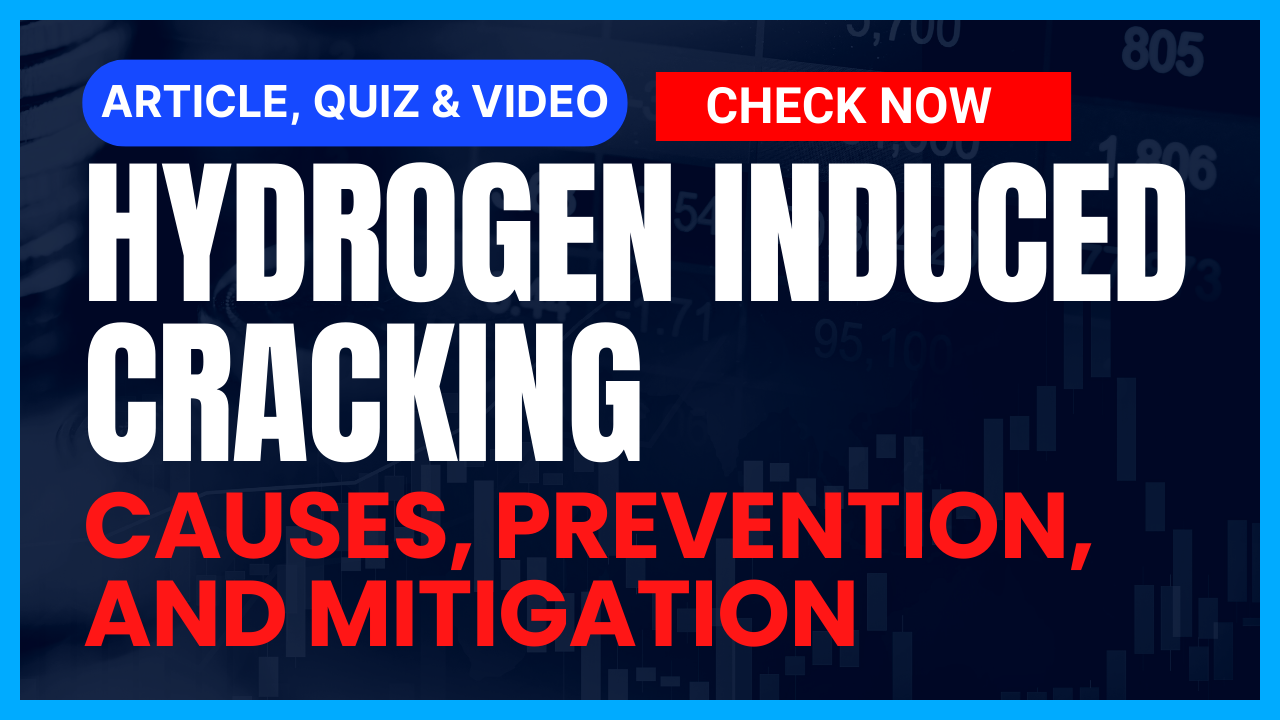Introduction
In the realm of industrial processes, piping systems play a crucial role in transporting fluids and gases. However, these systems are susceptible to various forms of degradation, one of which is hydrogen induced cracking (HIC). This phenomenon poses a significant threat to the integrity of piping systems in various industries. In this comprehensive guide, we will delve deep into the causes, prevention, and mitigation strategies for hydrogen induced cracking in piping.
Table of Contents
Understanding Hydrogen Induced Cracking (HIC)
Hydrogen induced cracking is a form of mechanical degradation that occurs due to the diffusion and accumulation of hydrogen within the metal microstructure. This accumulation of hydrogen can lead to the formation of cracks, weakening the material and potentially causing catastrophic failures. The phenomenon is particularly prominent in industries involving hydrogen-rich environments, such as oil and gas, petrochemicals, and chemical processing.
Causes of Hydrogen Induced Cracking
HIC is primarily caused by the interaction of hydrogen with susceptible metals under stress. Some common causes include:
- Corrosion: Corrosion reactions can liberate hydrogen ions that permeate the metal structure, leading to HIC.
- Hydrogen Sulfide (H2S) Exposure: Industries dealing with H2S-rich environments are at high risk, as H2S promotes the dissociation of hydrogen atoms, which can then infiltrate the metal.
- Welding and Heat Treatment: Welding and heat treatment processes can introduce hydrogen into the metal lattice, especially in the presence of moisture.
Recognizing the Signs of Hydrogen Induced Cracking
Detecting HIC in its early stages is crucial for preventing catastrophic failures. Look out for the following signs:
- Visible Cracks: External cracks on the surface of piping systems can be indicative of internal hydrogen-induced cracking.
- Reduced Load-Bearing Capacity: Weakened metal due to HIC may lead to reduced load-bearing capacity and structural integrity.
- Metal Fragments in Fluids: Finding metal fragments or particles in the transported fluids could be a sign of piping degradation.
Prevention and Mitigation Strategies
Addressing hydrogen induced cracking requires a multi-faceted approach involving materials selection, design considerations, and maintenance practices:
- Material Selection: Opt for materials with low susceptibility to hydrogen embrittlement, such as certain alloy steels.
- Cathodic Protection: Implement cathodic protection systems to reduce the likelihood of corrosion-induced hydrogen generation.
- Avoidance of Hydrogen-Rich Environments: Minimize exposure to hydrogen-rich environments whenever possible, especially in the design phase.
- Hydrogen Bake-Out: Post-weld heat treatments, such as hydrogen bake-outs, can help remove entrapped hydrogen.
Identifying Vulnerable Regions for Hydrogen Induced Cracking
The likelihood of encountering wet H2S damage, including HIC, during operational service is influenced by a range of variables. Moreover, the intricacies tied to process conditions, contaminants, welding practices, steel manufacturing, and stress factors contribute to diverse manifestations of wet H2S cracking and blistering.
Several sectors within refineries have exhibited distinct susceptibility to wet H2S damage, notably HIC. These areas encompass fluid catalytic cracking units (FCCUs), amine units, sulfur recovery units, and sour water stripper units. In FCCUs, challenges have arisen particularly within light ends recovery and fractionation equipment, especially downstream of wet gas compressors, intercoolers/aftercoolers, knock-out drums, sponge absorbers, and deethanizers. Within amine treating unit absorbers/contactors, a heightened risk zone lies near the inlet nozzles of sour gas. Similarly, sour water stripper unit overhead components such as condensers and reflux drums are also vulnerable to this form of damage.
Detecting Hydrogen Induced Cracking
Superficially, hydrogen induced cracking often assumes a horseshoe-like shape and maintains a size no larger than the cuticle of a small finger. To minimize the potential for hydrogen corrosion, it is imperative to engage in regular inspection and testing protocols. Among the established non-destructive testing (NDT) methods for identifying wet H2S cracking, Wet Fluorescent Magnetic Particle Testing (WFMPT) stands out. This technique exhibits the sensitivity required to consistently spot surface-breaking cracks within steel that result from HIC. Additionally, ultrasonic testing methodologies like shear wave (SWUT), phased array (PAUT) techniques, total focusing method (TFM), full matrix capture (FMC), and time of flight diffraction (TOFD) have demonstrated efficacy in categorizing and gauging wet H2S-induced damage, including HIC.
Regardless of the chosen NDT approach, a comprehensive grasp of limitations and potential sources of error is essential. Moreover, the involvement of qualified and experienced inspectors is paramount. Given the potential unpredictability and abrupt progression associated with mechanisms of wet H2S damage, consistent monitoring of high-risk equipment and regions previously identified as compromised is of utmost importance.
Unraveling the Mechanism of Hydrogen Induced Cracking (HIC)
The intricate process of hydrogen induced cracking commences with the dispersion of hydrogen atoms throughout the material via diffusion. Elevated temperatures contribute to heightened hydrogen solubility, enabling its penetration into the material’s matrix. Within minute voids, these hydrogen atoms coalesce, forming hydrogen molecules that exert pressure within the voids. As this pressure builds, it can progressively intensify, causing the metal’s tensile strength and ductility to dwindle. Eventually, this culminates in the formation of cracks, a phenomenon recognized as HIC.
Predisposed Materials and HIC Vulnerability
Materials particularly susceptible to HIC encompass low alloys and high-strength steels such as titanium and nickel. Generally, steels boasting a hardness below 30 HRC and a tensile strength beneath 145,000 psi or 1000 MPa demonstrate resilience against HIC.
Resilient Metals: Countering the Threat of HIC
Notably, copper and aluminum, alongside their respective alloys, stand out as steadfast adversaries to HIC. HIC has the potential to manifest across various phases of manufacturing operations, wherever metal interfaces with molecular or atomic hydrogen. Processes encompassing:
- Electroplating
- Phosphating
- Pickling
- Cathodic protection
are prone to precipitating HIC. Moreover, a prime setting for HIC occurrence lies within arc welding, a context where hydrogen emanates from moisture and organic compounds. Post-welding, HIC can materialize as early as 72 hours, diffusing at a rate of one inch per hour at 450°F. Although this prospect might raise concerns, preemptive measures exist. Ensuring immaculate cleanliness and the absence of moisture on weld surfaces, while maintaining a temperature range of 400-450°F for a duration of one hour, effectively forestalls the onset of HIC.
Criteria for Selecting Hydrogen-Induced Cracking Resistant Materials
Requirements for Carbon and Low Alloy Steels
- Parent Material Hardness Below 22HRC (237 BHN).
- Utilize Fully Killed Steel (Silicon/Aluminum).
- Subject to Heat Treatment: NORMALIZING / ANNEALING / Q AND T.
- Carbon Content < 0.23% and Carbon Equivalent (CE) < 0.43.
- Sulfur and Phosphorus Content < 0.002%.
- Consider Calcium Treatment and Inclusion Control.
Criteria for Austenitic Stainless Steel
- Parent Material Hardness Below 22HRC (237 BHN).
- Heat Treatment Involving Solution Annealing.
Criteria for Duplex and Super Duplex Stainless Steel
- Parent Material Hardness Below 25 HRC.
- Heat Treatment Involving Solution Annealing.
- Ferrite Ratio 35% to 65%.
Hydrogen-Induced Cracking Testing
The assessment of materials’ susceptibility to hydrogen-induced cracking involves rigorous testing procedures. NACE TM0284 protocol is commonly followed, wherein unstressed test specimens are exposed to an environment saturated with hydrogen sulfide gas at 1 bar pressure for 96 hours (4 days) as the standard test duration. Extended assessments up to 30 days use reduced hydrogen sulfide partial pressures.
Upon test completion, the specimens are thoroughly examined for the presence of cracks, which are subsequently measured. The evaluation criteria typically encompass Crack Sensitivity Ratio, Crack Length Ratio, and Crack Thickness Ratio.
Exploring Stress Oriented Hydrogen-Induced Cracking (SOHIC) Testing
An alternate HIC testing approach is the Stress Oriented Hydrogen-Induced Cracking (SOHIC) test, adhering to NACE MR0175 or ISO 15156. This method follows various testing standards, such as the full ring test in accordance with BS 8701, tensile test method as defined in NACE TM0177-Method A, or the four-point bend method as outlined in NACE TM0316. These techniques aim to scrutinize materials’ resilience against hydrogen-induced cracking under various stress orientations.
Frequently Asked Questions (FAQs)
FAQ 1: What is the main cause of hydrogen induced cracking in piping?
Hydrogen induced cracking is primarily caused by the interaction of hydrogen with susceptible metals under stress, often exacerbated by factors like corrosion and exposure to hydrogen-rich environments.
FAQ 2: Can stainless steel piping be susceptible to hydrogen induced cracking?
Yes, certain types of stainless steel can be susceptible to hydrogen induced cracking, particularly when exposed to hydrogen-sulfide-rich environments or during welding.
FAQ 3: How can I detect hydrogen induced cracking before it leads to failure?
Regular inspections using non-destructive testing methods like ultrasonic testing and radiography can help identify cracks and flaws before they lead to catastrophic failures.
FAQ 4: Are there any industry standards for preventing hydrogen induced cracking?
Yes, various industry standards and guidelines, such as NACE MR0175/ISO 15156, provide recommendations for materials, design, and operating conditions to mitigate hydrogen induced cracking risks.
FAQ 5: Can cathodic protection alone eliminate the risk of hydrogen induced cracking?
While cathodic protection can significantly reduce the risk of corrosion-induced hydrogen generation, it’s just one part of a comprehensive strategy. Other measures like material selection and design considerations are equally important.
Conclusion
Hydrogen induced cracking poses a serious threat to the integrity of piping systems in industries that deal with hydrogen-rich environments. By understanding the causes, recognizing the signs, and implementing preventive measures, such as proper material selection and design considerations, industries can effectively mitigate the risks associated with HIC. Vigilance, adherence to industry standards, and continuous maintenance are key to ensuring the long-term reliability of piping systems.
Recommended courses (Published on EPCLand)
- Basics of Piping Engineering
- Piping Layout Engineering
- Piping Material Engineering
- Piping Stress Analysis
- Complete Course on Piping Engineering
- Material Requisitions
- Piping Material Specifications
- Valve Material Specifications
Don’t miss the published articles on following:
Related Video
Attempt Quiz
Question 1:
What is hydrogen-induced cracking (HIC) in piping?
Explanation: Hydrogen-induced cracking (HIC) is a form of cracking that occurs in metals due to the presence of hydrogen, often resulting from exposure to hydrogen sulfide (H2S) or other sources of hydrogen.
Question 2:
What role does hydrogen play in the development of hydrogen-induced cracking?
Explanation: Hydrogen reduces the ductility of the metal and makes it more susceptible to cracking under stress, leading to hydrogen-induced cracking.
Question 3:
Which of the following is a common preventive measure against hydrogen-induced cracking?
Explanation: Using materials with high ductility, such as materials with good resistance to hydrogen-induced cracking, is a common preventive measure against this type of cracking.
Question 4:
What type of environments are more likely to cause hydrogen-induced cracking?
Explanation: Hydrogen-induced cracking is more likely to occur in hydrogen-sulfide-rich environments, where hydrogen atoms can permeate the metal and lead to cracking.
Question 5:
Which type of testing can be performed to detect the susceptibility of materials to hydrogen-induced cracking?
Explanation: Hydrogen embrittlement testing can be performed to assess the susceptibility of materials to hydrogen-induced cracking by subjecting specimens to a hydrogen environment and evaluating their response.



